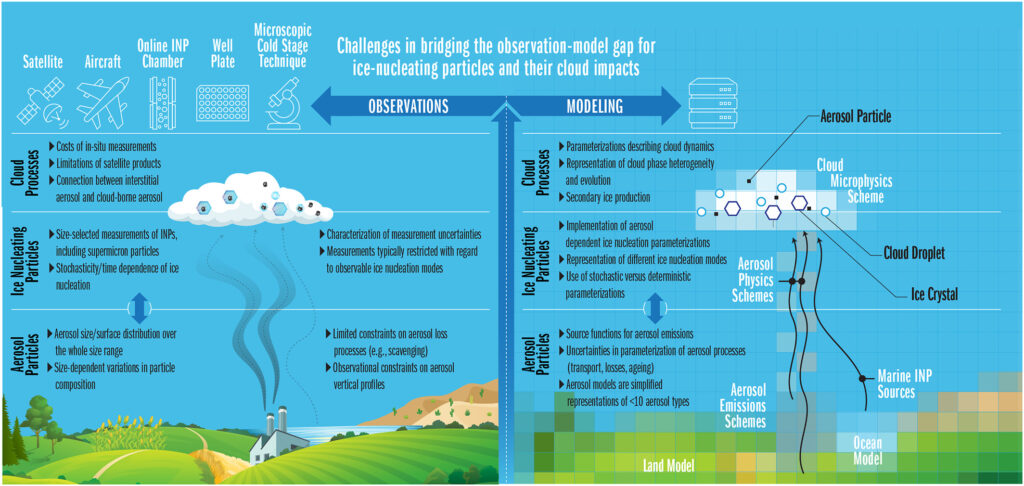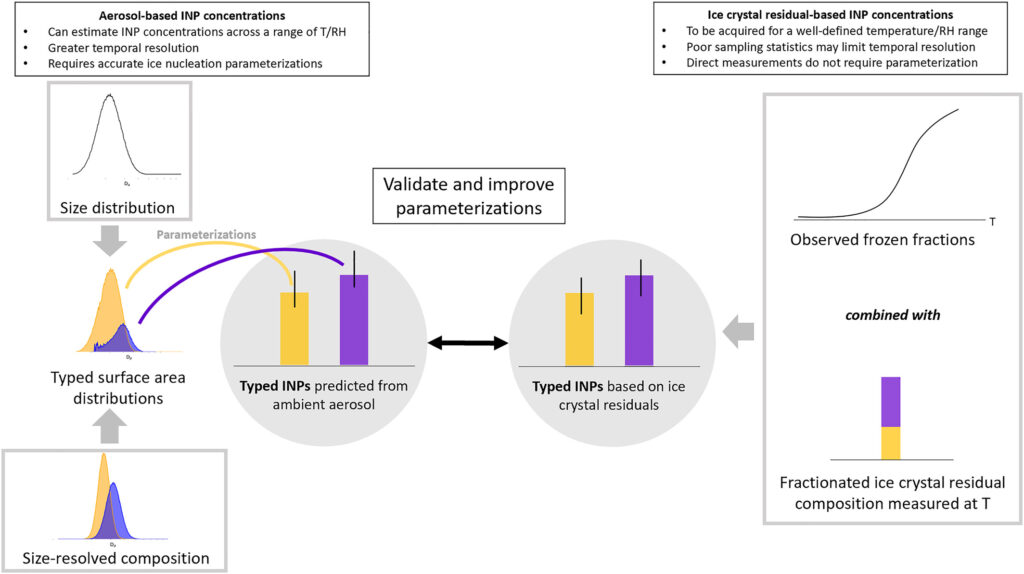Editors’ Vox is a blog from AGU’s Publications Department.
Atmospheric ice-nucleating particles (INPs) play a critical role in the formation of ice in clouds and thus impact precipitation experienced on the Earth’s surface, as well as climate by changing the amount of sunlight clouds reflect. However, much is still unknown about these particles, such as their sources and impacts on clouds.
A recent article in Reviews of Geophysics explores what is known about ice-nucleating particles and what knowledge and modeling gaps remain. Here, we asked the lead author to give an overview of these particles, how scientists study them, and opportunities for future research.
In simple terms, what are “ice-nucleating particles” (INPs) and how do they form?
Many types of particulate matter can be found in the air around us. These include human-caused pollution, but also naturally occurring particles such as agricultural soil dusts and mineral dusts from deserts, sea spray from the ocean, and biological particles such as pollen and fungal spores. Some of these particles can act as ice-nucleating particles, but with varying levels of efficiency.
Ice-nucleating particles (INPs) facilitate the formation of ice in clouds.
Ice-nucleating particles (INPs) facilitate the formation of ice in clouds. In the lower troposphere, the most important impact of INPs is that they can initiate freezing in mixed-phase clouds. In the upper troposphere, INPs can influence the formation and development of ice clouds (cirrus).
Why are ice-nucleating particles important?
Ice-nucleating particles (INPs) are important because they can have significant impacts on the formation of precipitation and the amount of sunlight that clouds reflect. For example, in low-level clouds, rain formation can be accelerated when cloud droplets freeze. When clouds can’t form ice they are less likely to produce rain, which means that less water is removed from the cloud and the cloud can persist longer. This type of persistent “supercooled” liquid cloud has been shown to occur frequently in the Arctic, where the relatively pristine atmospheric conditions mean that fewer INPs are available to enable cloud ice to form.
Studies using cloud-resolving models suggest that order-of-magnitude changes in INP concentrations are required to significantly impact clouds, but changes of this magnitude are common. In fact, INP concentrations are observed to span several orders of magnitude for a given freezing temperature and relative humidity, with large changes both between different geographic locations, and over time at a single geographic location.

Is it most useful to study INPs on a local, regional, or global scale?
Like many questions in atmospheric science, the answer is “all of the above”! But the research questions that we can pose and answer are different at each scale.
Studies of the detailed properties of INPs are most useful at local scales. Local studies focusing on details such as the chemical composition of individual INPs are labor-intensive and require sophisticated equipment but can provide powerful insights into the particle sources and atmospheric processes that control INP concentrations.
On the other hand, some particles that contribute to INPs, such as desert dusts, can be transported over long distances, so models that actively simulate INP sources and concentrations need to span from regional to global scales. Global models also play a critical role in understanding INP impacts on climate.
Bridging from the fundamental understanding and insights gained from local-scale studies, to study the impacts on climate in global models, is a fundamental and ongoing challenge to the research community.
Why are INPs difficult to measure?
INPs are challenging to measure because of their low atmospheric concentrations, which lead to large statistical sampling uncertainties. Another challenge that the INP measurement community has been grappling with is related to particle size. Particles with diameters from around 1 to 5 micrometers often contribute a significant fraction of the INPs in near-surface air, but many INP measurement devices are not able to quantify INPs in this size range due to various technical challenges.
Practical obstacles have also played a role. Historically, conducting INP measurements was labor-intensive, and required highly trained human operators. Additionally, INP measurement devices were not available commercially, but instead were built one-at-a-time by individual research groups, which is a barrier to entry that not all research groups have adequate time and resources to overcome. Consequently, INP measurements historically were performed at few locations and for short periods of time, and by a relatively small number of research groups.
What are some recent advances in INP measurement and modeling techniques?
Recently, several commercially available INP counters have been developed, which lowers the barrier to entry for researchers wishing to measure INPs. New measurement methods are also being developed rapidly. For example, one frontier has been the development of microfluidic INP counters, which enable higher-throughput measurements of INPs and integrate well with detailed particle characterization techniques. These and other new technologies are likely to dramatically accelerate our knowledge of INPs in the coming decade. Modeling of INPs is also advancing rapidly.
During the past 15 years, improved source functions and improved parameterizations for INP efficiency have enabled researchers to begin more explicitly representing INPs in regional and global models. Due to the increased availability of INP measurements, researchers are also able to evaluate model simulation of INPs in greater detail than was possible in past decades. With these recent advances, the cloud and climate modeling community is poised for a new generation of research that will transform our understanding of INPs and their impacts on clouds and climate.

Why is there an observation-model gap for INPs and their aerosol sources?
In addition to the technical challenges discussed above, there is also a broader issue related to the sociology of science. The study of INPs and their cloud and climate impacts are intrinsically inter-disciplinary and requires researchers to work together across several areas of expertise. Historically, the researchers working on INP measurements, models of their aerosol sources, and measurements and models of the clouds that are impacted by INPs, have often worked in parallel, largely separate research communities.
Bridging these research communities requires building teams of collaborative scientists who are willing to take risks and invest time into working together and learning each others’ scientific “languages”. In working together across research communities, we develop a deeper appreciation of each others’ research problems and obstacles, which often result in creative new solutions and fresh perspectives. Collaborations between modelers and experimentalists have historically been especially fruitful in advancing research on broad topics, such as aerosol-cloud interactions, and can be expected to bear fruit in this arena as well.
If the scientific community is able to close this gap, what kinds of achievements or advances in knowledge could be made?
Closing the measurement-model gap for INPs would mean that we have developed both a better fundamental understanding of the processes controlling INP concentrations and their freezing behavior in clouds, and a better understanding of how to appropriately represent INPs in aerosol-aware cloud models.
By linking model prediction of INPs to an improved fundamental understanding of their sources, we will unlock new research questions that help us to understand the role of INPs in a changing Earth System.
By linking model prediction of INPs to an improved fundamental understanding of their sources, we will unlock new research questions that help us to understand the role of INPs in a changing Earth System. For example, the retreat of Arctic sea ice, increased desertification, and changes in land management practices all have the potential to modify the availability and efficacy of INPs to clouds.
In cloud regimes that are sensitive to INP concentrations, the radiation balance and precipitation produced by those clouds can be modified, with potential impacts on climate. Closing the measurement-model gap for INPs will position the research community to be able to simulate and study these processes in the context of a changing Earth System.
—Susannah M. Burrows ([email protected]; ![]() 0000-0002-0745-7252), Pacific Northwest National Laboratory, USA
0000-0002-0745-7252), Pacific Northwest National Laboratory, USA
Editor’s Note: It is the policy of AGU Publications to invite the authors of articles published in Reviews of Geophysics to write a summary for Eos Editors’ Vox.

